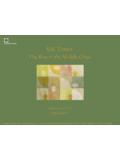Transcription of The Emerging Middle Class in Developing Countries
1 The Emerging Middle Class in Developing Countries Homi Kharas March 15, 2010. 0. Introduction As an economic driver, the Middle Class may be termed the Consumer Class . The Middle Class income elasticity for consumer durables and services is greater than one. This paper looks at the potential growth of the Middle Class in the Developing world over the next 25 years This paper traces whether the Emerging Asian Middle Class will be large enough to replace the US as a driver of Global Economy 1. Defining Middle Class Global Middle Class defined as households with daily expenditures between US$ 10 and US$ 100 per person The lower bound is chosen with reference to the average poverty line in Portugal and Italy The upper bound is chosen as twice the median income of Luxemburg Thus, the global Middle Class excludes those who are considered poor in the poorest advanced Countries and those who are considered rich in the richest advanced country 2. Measuring Global Middle Class Develop estimates for 145 Countries , accounting for 98% of population and 99% of GDP.
2 Measure both the number of people in Middle Class and their consumption shares Table 1: The Global Middle Class , 2009: People and Spending Number of People (millions and global Consumption (billions share) PPP$ and global share). North America 338 18% 5,602 26%. Europe 664 36% 8,138 38%. Central and South America 181 10% 1,534 7%. Asia Pacific 525 28% 4,952 23%. Sub-Saharan Africa 32 2% 256 1%. Middle East and North Africa 105 6% 796 4%. World 1,845 100% 21,278 100%. 3. Projection Result 1: Global output will accelerate and Asia will drive this output Figure 3. World Economic Output Over 50 Years, 1984-2034 (2005 PPP dollars). +14. +14. +14. GDP (PPP). +14. +13. +00. 84. 87. 90. 93. 96. 99. 02. 05. 08. 11. 14. 17. 20. 23. 26. 29. 32. 19. 19. 19. 19. 19. 19. 20. 20. 20. 20. 20. 20. 20. 20. 20. 20. 20. World North America Central and South America Asia Pacific Sub-Saharan Africa Middle East and North Africa Europe 4. Projection Result 2: The Economic Center of Gravity Shifts East 5.
3 Projection Result 3: Economic growth drives people into the Middle Class Notice the number of people clustered under $10/day threshold level in China who enter the Middle Class over time 6. Projection Result 4: The Middle Class is projected to grow from billion to billion by 2020 to billion by 2030. Table 2. Numbers (millions) and Share (percent) of the Global Middle Class - Asia Pacific Middle Class increases from 28% to 66% of the world 2009 2020 2030. North America 338 18% 333 10% 322 7%. Europe 664 36% 703 22% 680 14%. Central and South America 181 10% 251 8% 313 6%. Asia Pacific 525 28% 1,740 54% 3,228 66%. Sub-Saharan Africa 32 2% 57 2% 107 2%. Middle East and North Africa 105 6% 165 5% 234 5%. World 1,845 100% 3,249 100% 4,884 100%. Table 3. Spending by the Global Middle Class , 2009 to 2030 (billions of 2005 PPP dollars). - Asia Pacific share of world spending increases from 23% to 59%. 2009 2020 2030. North America 5,602 26% 5,863 17% 5,837 10%.
4 Europe 8,138 38% 10,301 29% 11,337 20%. Central and South America 1,534 7% 2,315 7% 3,117 6%. Asia Pacific 4,952 23% 14,798 42% 32,596 59%. Sub Saharan Africa 256 1% 448 1% 827 1%. Middle Eastern and North Africa 796 4% 1,321 4% 1,966 4%. World 21,278 100% 35,045 100% 55,680 100%. 7. Projection Result 6: China and India increase their shares of Middle Class consumption Figure 7: India and China Make Waves in the Global Middle Class Shares of Global Middle Class Consumption, 2000-2050. 100%. 90%. 80%. Others 70%. EU. 60% United States 50% Japan 40% Other Asia India 30%. China 20%. 10%. 0%. 00. 03. 06. 09. 12. 15. 18. 21. 24. 27. 30. 33. 36. 39. 42. 45. 48. 20. 20. 20. 20. 20. 20. 20. 20. 20. 20. 20. 20. 20. 20. 20. 20. 20. 8. Conclusions The Middle Class is an important consumption Class as their income elasticity for durable goods and services is greater than one In the future the Middle Class growth is projected to come mainly from Asia India and China continue on their trajectory of high growth coupled with a growing Middle Class An economic realignment is projected with economic center of gravity will shift from Europe to Asia 9.














